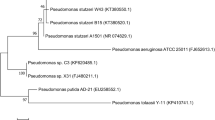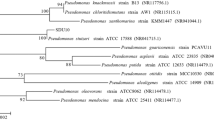Abstract
A high concentration of NH +4 in piggery wastewater is major problem in Taiwan. Therefore, in our study, we isolated native heterotrophic nitrifiers for piggery wastewater treatment. Heterotrophic nitrifier AS-1 was isolated and characterized from the activated sludge of a piggery wastewater system. Sets of triplicate crimp-sealed serum bottles were used to demonstrate the heterotrophic nitrifying capability of strain AS-1 in an incubator at 30°C. All serum bottles contained 80 mL medium, and the remainder of the bottle headspace was filled with pure oxygen. The experimental results showed that 2.5 ± 0.2 mmol L−1 NH +4 was removed by 58 hours, and, eventually, 1.5 ± 0.5 mmol L−1 N2 and 0.2 ± 0.0 mmol L−1 N2O were produced. The removal rate of NH +4 by the strain AS-1 was 1.75 mmol NH +4 g cell−1 h−1. This strain was then identified as Pseudomonas alcaligenes (97% identity) by sequencing its 16S rDNA and comparing it with other microorganisms. Thus, strain AS-1 displays high promise for future application for in situ NH +4 removal from piggery wastewater.



Similar content being viewed by others
Literature Cited
Bennasar A, Guasp C, Lalucat J (1998) Molecular methods for the detection and identification of Pseudomonas stutzeri in pure culture and environmental samples. Microb Ecol 35:22–33
Bock E, Schmidt I, Stüven R, Zart D (1995) Nitrogen loss caused by denitrifying Nitrosomonas cells using ammonium or hydrogen as electron donors and nitrite as electron acceptor. Arch Microbiol 163:16–20
Brierley EDR, Wood M (2001) Heterotrophic nitrification in an acid soil: Isolation and characterization of a nitrifying bacterium. Soil Biol Biochem 33:1403–1409
Castignetti D, Hollocher TC (1984) Heterotrophic nitrification among denitrifiers. Appl Environ Microbiol 47:620–623
Daniels L, Hanson RS, Phillips JA (1994) Chemical analysis. In: Gerhardt P, Murray RGE, Wood WA, Krieg NR (eds) Methods for general and molecular bacteriology. Washington, DC, American Society for Microbiology, pp 537–539, 541–542
Doxtader KG, Alexander M (1966) Nitrification by heterotrophic soil microorganisms. Soil Sci Soc Am Proc 30:351–355
Eylar OR, Schmidt EL (1959) A survey of heterotrophic soil microorganisms from soil for ability to form nitrite and nitrate. J Gen Microbiol 20:473–481
Gupta AB (1997) Thiosphaera pantotropha: A sulphur bacterium capable of simultaneous heterotrophic nitrification and aerobic denitrification. Enzyme Microb Technol 21:589–595
Johnsrud SC (1978) Heterotrophic nitrification in acid forest soils. Holarctic Ecol 1:27–30
Koch AL (1994) Growth measurement. In: Gerhardt P, Murray RGE, Wood WA, Krieg NR (eds) Methods for general and molecular bacteriology. Washington, DC, American Society for Microbiology, pp 260–261
Littleton HX, Daigger GT, Strom PF, Cowan RA (2003) Simultaneous biologic nutrient removal: Evaluation of autotrophic denitrification, heterotrophic nitrification, and biologic phosphorus removal in full-scale systems. Water Environ Res 75:138–150
Papen H, von Berg R, Hinkel I, Thoene B, Rennenberg H (1989) Heterotrophic nitrification by Alcaligenes faecalis: NO −2 , NO −3 , N2O, and NO production in exponentially growing cultures. Appl Environ Microbiol 55:2068–2072
Robertson LA, VanNiel EW, Torremans RAM, Kuenen JG (1988) Simultaneous nitrification and denitrification in aerobic chemostat of Thiosphaera pantotropha. Appl Environ Microbiol 54:2812–2818
Robertson LA, Cornelisse R, De Vos P, Hadioetomo R, Kuenen JG (1989) Aerobic denitrification in various heterotrophic nitrifiers. Antonie Van Leeuwenhoek 56:289–299
Schmidt I, Bock E (1997) Anaerobic ammonia oxidation with nitrogen dioxide by Nitrosomonas eutropha. Arch Microbiol 167:106–111
Stouthamer AH, de Boer APN, van der Oost J, van Spanning RJM (1997) Emerging principles of inorganic nitrogen metabolism in Paracoccus denitrificans and related bacteria. Antonie Van Leeuwenhoek 71:33–41
Su JJ, Liu YL, Shu FJ, Wu JF (1997) Treatment of piggery wastewater treatment by contact aeration treatment in coordination with the anaerobic fermentation of three-step piggery wastewater treatment (TPWT) process in Taiwan. J Environ Sci Health A Tox Hazard Subst Environ Eng 32:55–73
Su JJ, Liu BY, Lin J, Yang JB (2001) Isolation of an anaerobic denitrifying bacterial strain NS-2 from the activated sludge of piggery wastewater treatment systems in Taiwan possessing denitrification under 92% atmosphere. J Appl Microbiol 91:853–860
Su JJ, Liu BY, Liu CY (2001) Comparison of aerobic denitrification under pure oxygen atmosphere by Thiosphaera pantotropha ATCC 35512 and Pseudomonas stutzeri SU2 newly isolated from the activated sludge of a piggery wastewater treatment system. J Appl Microbiol 90:457–462
Su JJ, Liu BY, Chang YC (2001) Identification of an interfering factor on chemical oxygen demand (COD) determination in piggery wastewater and elimination of the factor by an indigenous Pseudomonas stutzeri strain. Lett Appl Microbiol 33:440–444
Su JJ, Liu BY, Chang YC (2003) Emission of greenhouse gas from livestock waste and wastewater treatment in Taiwan. Agric Ecosyst Environ 95:253–263
Third KA, Burnett N, Cord-Ruwisch R (2003) Simultaneous nitrification and denitrification using stored substrate (PHB) as the electron donor in an SBR. Biotechnol Bioeng 83:706–720
Van Goole AP, Schmidt EL (1973) Nitrification in relation to growth in Aspergillus flavus. Soil Biol Biochem 5:259–265
Van Loosdrecht MCM, Jetten MSM (1998) Microbiologic conversions in nitrogen removal. Water Sci Technol 38:1–7
VanNiel EW, Braber KJ, Robertson LA, Kuenen JG (1992) Heterotrophic nitrification and aerobic denitrification in Alcaligenes faecalis strain TUD. Antonie Van Leeuwenhoek 62:231–237
Verstraete W, Alexander M (1972) Heterotrophic nitrification by Arthrobacter sp. J Bacteriol 110:955–961
Acknowledgments
The investigators thank the National Science Council, Executive Yuan of the Republic of China, Taiwan, for financially supporting this research under Contract No. NSC 91−2317-B-059-004. E. D. R. Brierley, Institute of Water and Environment, Cranfield University, UK, is appreciated for providing valuable reference papers and advice. In adition, R. H. Chen is appreciated for helping with portions of the experiments.
Author information
Authors and Affiliations
Corresponding author
Rights and permissions
About this article
Cite this article
Su, JJ., Yeh, KS. & Tseng, PW. A Strain of Pseudomonas sp. Isolated from Piggery Wastewater Treatment Systems with Heterotrophic Nitrification Capability in Taiwan. Curr Microbiol 53, 77–81 (2006). https://doi.org/10.1007/s00284-006-0021-x
Received:
Accepted:
Published:
Issue Date:
DOI: https://doi.org/10.1007/s00284-006-0021-x




